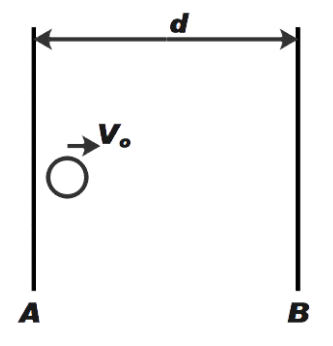
A super ball is to bounce elastically back and forth between two rigid walls at a distance d from each other. Neglecting gravity and assuming the velocity of super ball to be \[{{V}_{o}}\] horizontally, the average force (in large time interval) being exerted by the super ball on the wall is:
A. \[\dfrac{1}{2}\dfrac{mV_{o}^{2}}{d}\]
B. \[\dfrac{mV_{o}^{2}}{d}\]
C. \[\dfrac{2mV_{o}^{2}}{d}\]
D. \[\dfrac{4mV_{o}^{2}}{d}\]
Answer
559.8k+ views
Hint: In this question, we are asked to calculate the force exerted by the ball on the wall. We know that force is given as the rate of change of momentum. We also know that the distance travelled is the speed of the object over time required. We will be using these concepts to solve this question.
Formula used: -
\[F=\dfrac{\Delta p}{t}\]
Where,
F is the force
P is the momentum
t is the time
Complete step by step answer:
A super ball strikes the walls separated by distance d as shown in the figure below.

It is given that gravity is neglected and the velocity is given as \[{{V}_{o}}\]. From Newton's second law of motion we know that the force is given as rate of change of momentum.
\[F=\dfrac{\Delta p}{t}\] ………… (1)
Since, the ball will hit the wall and return back to the other wall in opposite direction with same velocity, the change in momentum of the ball will be given as,
\[\Delta p=m{{V}_{o}}-(-m{{V}_{o}})\]
Therefore,
\[\Delta p=2m{{V}_{o}}\] …………………. (2)
Now, we know that time can be given as total distance travelled over velocity. As shown in the figure above, the distance between two walls is d. Therefore, total distance travelled by the ball before hitting the same wall will be 2d
Therefore,
\[t=\dfrac{2d}{{{V}_{o}}}\] ……………… (3)
Now, after substituting the value from equation (2) and (3) in equation (1)
We get,
\[F=\dfrac{2m{{V}_{o}}}{\dfrac{2d}{{{V}_{o}}}}\]
On solving,
We get,
\[F=\dfrac{m{{V}_{o}}^{2}}{d}\]
Therefore, the correct answer is option B.
Note: Momentum is a quantity of motion that an object with certain mass has. It is a vector quantity having both direction and magnitude. According to Newton’s second law the acceleration of an object depends on the force applied and the mass of the object. That means that if a force is not applied on an object the acceleration will be zero. Therefore, if an object is at rest will continue to be at res until external force is applied. This is the first law of Newton. The first law is contained in the second law in such a manner.
Formula used: -
\[F=\dfrac{\Delta p}{t}\]
Where,
F is the force
P is the momentum
t is the time
Complete step by step answer:
A super ball strikes the walls separated by distance d as shown in the figure below.

It is given that gravity is neglected and the velocity is given as \[{{V}_{o}}\]. From Newton's second law of motion we know that the force is given as rate of change of momentum.
\[F=\dfrac{\Delta p}{t}\] ………… (1)
Since, the ball will hit the wall and return back to the other wall in opposite direction with same velocity, the change in momentum of the ball will be given as,
\[\Delta p=m{{V}_{o}}-(-m{{V}_{o}})\]
Therefore,
\[\Delta p=2m{{V}_{o}}\] …………………. (2)
Now, we know that time can be given as total distance travelled over velocity. As shown in the figure above, the distance between two walls is d. Therefore, total distance travelled by the ball before hitting the same wall will be 2d
Therefore,
\[t=\dfrac{2d}{{{V}_{o}}}\] ……………… (3)
Now, after substituting the value from equation (2) and (3) in equation (1)
We get,
\[F=\dfrac{2m{{V}_{o}}}{\dfrac{2d}{{{V}_{o}}}}\]
On solving,
We get,
\[F=\dfrac{m{{V}_{o}}^{2}}{d}\]
Therefore, the correct answer is option B.
Note: Momentum is a quantity of motion that an object with certain mass has. It is a vector quantity having both direction and magnitude. According to Newton’s second law the acceleration of an object depends on the force applied and the mass of the object. That means that if a force is not applied on an object the acceleration will be zero. Therefore, if an object is at rest will continue to be at res until external force is applied. This is the first law of Newton. The first law is contained in the second law in such a manner.
Recently Updated Pages
Why are manures considered better than fertilizers class 11 biology CBSE

Find the coordinates of the midpoint of the line segment class 11 maths CBSE

Distinguish between static friction limiting friction class 11 physics CBSE

The Chairman of the constituent Assembly was A Jawaharlal class 11 social science CBSE

The first National Commission on Labour NCL submitted class 11 social science CBSE

Number of all subshell of n + l 7 is A 4 B 5 C 6 D class 11 chemistry CBSE

Trending doubts
1 Quintal is equal to a 110 kg b 10 kg c 100kg d 1000 class 11 physics CBSE

What is Environment class 11 chemistry CBSE

Bond order ofO2 O2+ O2 and O22 is in order A O2 langle class 11 chemistry CBSE

How many squares are there in a chess board A 1296 class 11 maths CBSE

Distinguish between verbal and nonverbal communica class 11 english CBSE

The equivalent weight of Mohrs salt FeSO4 NH42SO4 6H2O class 11 chemistry CBSE




